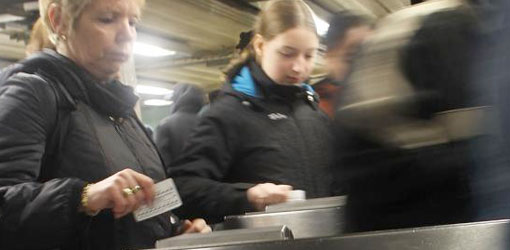Beep! Beep! Beep!
Posted on November 30, 2012 | posted by: According to Professor Birgit Mager, who runs the Cologne-based Service Design Network, “Service design addresses the functionality and form of services from the perspective of clients. It aims to ensure that service interfaces are useful, usable, and desirable from the client’s point of view and effective, efficient, and distinctive from the supplier’s point of view.” No one can deny that the service design of the New York City subway system isn’t distinctive. In fact, riding the subway is often an overwhelming sensorial experience. From the smell of a century’s worth of oil and decaying superstructure to the slick/gritty feel of the train poles and seating, one’s senses are continually assaulted. Many New Yorkers take pride in the fact that their train system is just as brash and unapologetically practical as the residents it shuttles throughout the five boroughs. But for visitors and newcomers alike, riding the subway can be a moderately to very uncomfortable experience.
According to Professor Birgit Mager, who runs the Cologne-based Service Design Network, “Service design addresses the functionality and form of services from the perspective of clients. It aims to ensure that service interfaces are useful, usable, and desirable from the client’s point of view and effective, efficient, and distinctive from the supplier’s point of view.” No one can deny that the service design of the New York City subway system isn’t distinctive. In fact, riding the subway is often an overwhelming sensorial experience. From the smell of a century’s worth of oil and decaying superstructure to the slick/gritty feel of the train poles and seating, one’s senses are continually assaulted. Many New Yorkers take pride in the fact that their train system is just as brash and unapologetically practical as the residents it shuttles throughout the five boroughs. But for visitors and newcomers alike, riding the subway can be a moderately to very uncomfortable experience.
Some of these inconveniences, it might be argued, cannot be avoided, as the various touch-points within the system are predicated on its age. However, there are a few aspects of the rider experience that may be improved. One place to start may be the auditory environment. Trains rumble and clatter into and out of stations; the idling whir of engine fans can be deafening, incomprehensible conductor announcements; all sustained by the continual background beeping of the subway turnstiles.
The beeping—the beeping that cannot be ignored once your attention has been turned to it. Especially busy subway stations, like Union Square, are a cacophony of a single high-pitched tone as people rush through the turnstiles to enter the system. Once a card is swipped the turnstile beeps to indicate that the card has been read and that a rider can proceed through to the platform. At face value the sound seems like an effective indicator of turnstile use, however upon further examination one begins to see where it is a failure in the design of what could be a very useful touch-point.
The major shortcoming of the beep emitted by the turnstile is that it is the same regardless of a variety of factors. There is no differentiation made between a successful swipe when the card has been read by the machine or if the card needs to be re-swiped. The same tone is heard whether your card is low on funds nor whether your monthly pass is due to expire. Tweaking the turnstiles to emit different sounds based on a variety of conditions would in all likelihood only require a negligible amount of coding, so why hasn’t something like this been implemented?
Perhaps there were budgetary constraints. Perhaps there was never any discussion about how the turnstiles were going to be used. What we can glean from this particular example is that real thought about the user experience must always be at the center of the design of a system and perhaps more importantly its touch-points. Yes, the design process is often hemmed in by environmental limitations—as in this case, the practical considerations of an old and aging subway system—but interventions can, and should be, unpacked and examined before they are implemented.